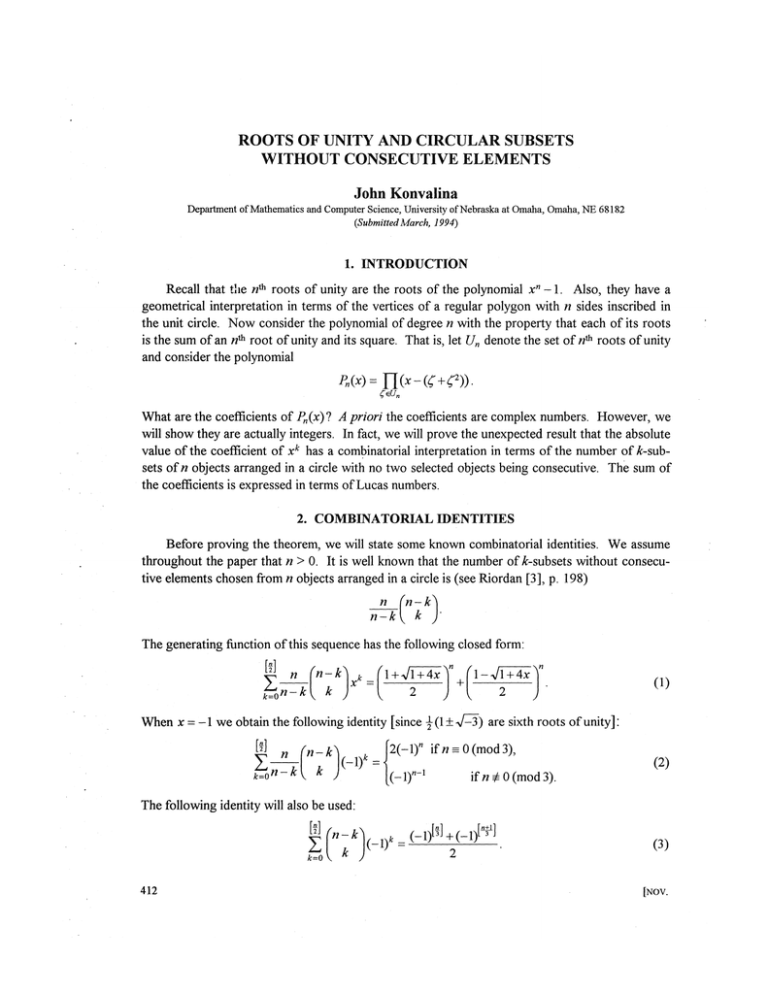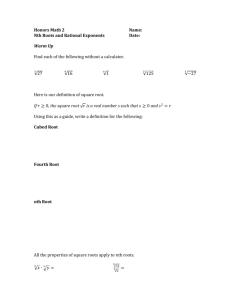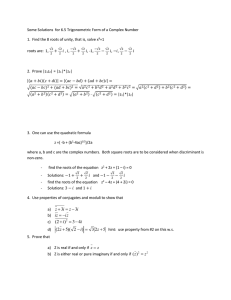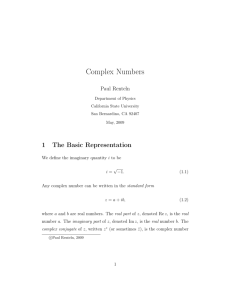Document 10292504
advertisement

ROOTS OF UNITY AND CIRCULAR SUBSETS
WITHOUT CONSECUTIVE ELEMENTS
John Konvalina
Department of Mathematics and Computer Science, University of Nebraska at Omaha, Omaha, NE 68182
(Submitted March, 1994)
1. INTRODUCTION
Recall that the nth roots of unity are the roots of the polynomial xn - 1 . Also, they have a
geometrical interpretation in terms of the vertices of a regular polygon with n sides inscribed in
the unit circle. Now consider the polynomial of degree n with the property that each of its roots
is the sum of an nth root of unity and its square. That is, let U„ denote the set of nth roots of unity
and consider the polynomial
What are the coefficients of Pn(x) ? A priori the coefficients are complex numbers. However, we
will show they are actually integers. In fact, we will prove the unexpected result that the absolute
value of the coefficient of xk has a combinatorial interpretation in terms of the number of ^-subsets of n objects arranged in a circle with no two selected objects being consecutive. The sum of
the coefficients is expressed in terms of Lucas numbers.
2. COMBINATORIAL IDENTITIES
Before proving the theorem, we will state some known combinatorial identities. We assume
throughout the paper that n > 0. It is well known that the number of ^-subsets without consecutive elements chosen from n objects arranged in a circle is (see Riordan [3], p. 198)
n (n-k^
n~k{ k
The generating function of this sequence has the following closed form:
[f]
k=0
r
n-k\
k
_(\ + J\ + 4xX , fl-Vl + 4xY'
2
n-k
)
\
2
(1)
When x = - 1 we obtain the following identity [since % (1 + V-3) are sixth roots of unity]:
SI n (n-k
k=0
(-1) =
n-k
f2(-l)" if/i s 0 (mod 3),
«-i
(-1)'
if«#0(mod3).
(2)
The following identity will also be used:
l
$(»-*X (-1>n*_(-0W+H)["]
(3)
k=0
412
[NOV.
ROOTS OF UNITY AND CIRCULAR SUBSETS WITHOUT CONSECUTIVE ELEMENTS
References for these combinatorial identities include Graham, Knuth, & Patashnik [2], pp.
178-79 and 204, or Riordan [4], pp. 75-77, or Gould [1], Identities 1.64, 1.68, and 1.75.
3. THE THEOREM
Theorem: The roots of the polynomial
[f]
p n (*)=*« + H)«-£-^":*y
\n-k\
k
(4)
k=Q'
are precisely the n complex numbers (not necessarily distinct) of the form C + C2, where £ ranges
over U„ the 72th roots of unity. That is,
n(*-(^o)=*"+(-ir-i^fVV£dJn
k=0n
th
K
\
Proof: Let C, denote any n root of unity. Then x = C + C2
* J
ls a r o o t
°f Pn{x) of and only if
t^f w I*]^ + ^)*^+^) ,, +(-l) ,, = (l+0',+(-l)^
w
*=o -K
k
0)
)
But (5) follows immediately from (1) since l + 4(^ + ^ ) = (2^ + l)2 and ^n = 1. Hence, if the n
complex numbers, C,+t?, are distinct as C, ranges over U„, then all roots of Pn(x) have been
determined.
To complete the proof, we will show all the roots are distinct except when n = 0 (mod 3). In
that case, x = - 1 will be a double root. To verify this, first observe that by (2) and (4) x - -1 is a
root of Pn(x) if and only if n = 0 (mod 3). Now the derivative of P„(x) is
P;(x) =
t\n-2-k\
nx"-l-nJd
k=0
V
k
k
'
( )
So x - -1 is a root of P'n{x) if and only if
ll w i~*V 1 )*=(- i r 1 k=o\
J
But, if n = 0 (mod 3), then (7) follows immediately from (3) with n replaced by n-2
that [since (-1)"/3 = (-1)"]
(_l)M
^
=
and noting
(-l)J,fa = ( - l ) - i .
Thus, x = - 1 is at least a double root of Pn(x) when n = 0 (mod 3). Finally, we will show x = -l
is in fact a double root. First, however, a lemma to determine when the sum of two nth roots of
unity is equal to - 1 .
1995]
413
ROOTS OF UNITY AND CIRCULAR SUBSETS WITHOUT CONSECUTIVE ELEMENTS
Lemma: Let C,n denote the primitive rfi1 root of unity cos-^f + Zsin^f. Suppose
Then, for somey and k, £Jn + £kn - -1 if and only if n = 3 j and k = 2j.
0<j<k<n.
Proof: Ifn = 3/ and Jfc = 2 / , then <^y + ^ is a sum of the primitive cube roots of unity and,
hence, is equal to - 1 . Conversely, suppose the sum of the two nth roots of unity is equal to - 1 .
Equating real and imaginary parts, we obtain cos~fy' + cos-~k = - 1 and sin-^fy + sin^f £ = 0.
Now solve for cos^fk and sin^-k:
2n j
-
2;r .
/ON
cos—k = - l - c o s — /
(8)
n
n
and
. 2n ,
. 2n .
/m
sin — & = - s i n — /.
(9)
n
n
Next, square both sides of (8) and (9), then add to obtain c o s ^ y j = - y . Similarly, solving the
original equations for cos^f y'and sin^fy, we obtain cos(^^) = - y . Since 0< j <k <n, we
must have ^-j-^f- and ^f-k = 4 p Hence, n = 3y and 3k~2n.
Therefore, n = 3y and k - 2y,
and the lemma is proved.
Now we return to the proof of the theorem to determine when the roots of P„(x) will not be
distinct. Suppose 0 < j < k < n and two roots are the same. Then
a+ciJ=ck„+C
(io)
Hence, Ci ~ Ck„ = C - ClJ = (Ck„ - OiC + Ci) • So wemusthave
#+tf = -l.
£Jn
(11)
£kn
Therefore, by the lemma,
and are the primitive cube roots of unity. Since the square of one
primitive cube root of unity is the other primitive cube root, the root x = -l will occur exactly
twice in (^ + C as C, ranges over the nth roots of unity for n = 0 (mod 3).
\-Ln
if n is odd,
.
Corollary: Pn(l) = <
where Ln is the nm Lucas number.
[-L„ + 2 if n is even,
Proof: It is well known that Z ^ o ^ r * * ) = Ln, where Ln is the nth Lucas number.
REFERENCES
1.
2.
3.
4.
H.W.Gould. Combinatorial Identities. Morgantown, WV, 1972.
R. L. Graham, D. E. Knuth, & O. Patashnik. Concrete Mathematics: A Foundation for
Computer Science. Reading, MA: Addison-Wesley, 1989.
J. Riordan. An Introduction to Combinatorial Analysis. New York: Wiley, 1958.
J. Riordan. Combinatorial Identities. New York: Wiley, 1968.
AMS Classification Number: 05A15
414
[NOV.





